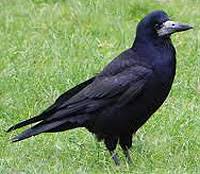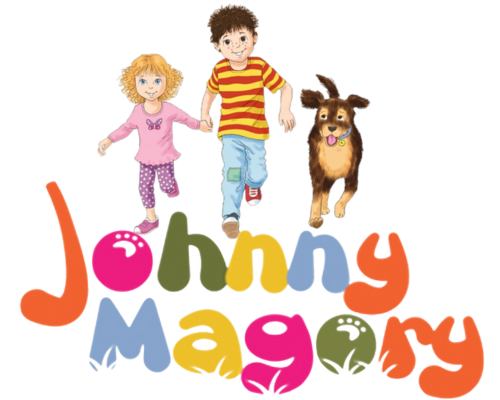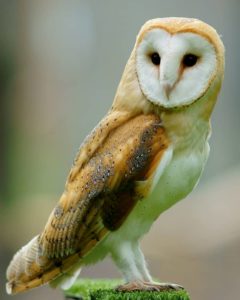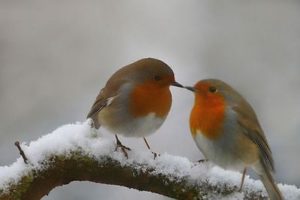Even though the trees may be sparse and bare in wintertime in Ireland, it offers ample opportunity to view and watch your favourite birds go about their daily lives.
Here’s a round up of our favourite feathered friends to observe at this time of year.
Johnny Magory’s Irish Animal and Bird Directory
Remember to visit our Irish Animal Directory for fun facts on all your favourite Irish animals which we add to regularly.

Crow-Beanna
- The lifespan of a crow is 7-8 years
- Crows have shiny jet black plumage with curious eyes, hoping gait, & a remarkable level of intelligence.
- With more than 120 species, crows thrive in almost all the continents, other than Antartica.
- Crows belong to the genus Corvus in the family Corvidae.
- “Cawing” is the sound they make & they have a sophisticated form of communication language.
- They usually lay 4-7 eggs at a time.
- They have a single mate their entire life.
- Crows have the biggest brain to body ratio among all bird species. Evolved with a highly developed forebrain, where intelligence is regulated, the anatomy of the crow brain is much similar to humans’.
- Just like parrots, crows can imitate human voice but they are more intelligent than parrots. Crows are known to use tools &methods for getting food such as leaving a nutshell on a road so a car will drive over it to crack it for them!
- Crows, particularly ravens, have strong connections with European folklore and mythology. Particularly in Celtic and Norse mythology. Ravens were the messengers of the Irish and Welsh gods and were associated with battle and prophecy.
- Aesop’s famous fable “The crow and the pitcher” demonstrates the crows intelligence.
- The story concerns a thirsty crow that comes upon a pitcher with water at the bottom, beyond the reach of its beak. After failing to push it over, the bird drops in pebbles one by one until the water rises to the top of the pitcher, allowing it to drink.
- So next time you hear a “caw” say hello to this remarkable bird… It might just say hello back!
Barn Owl-Scréachóg Reilige
- Irish for barn owl is Scréachóg reilige.
- Average life span is 4 years, the oldest recorded was 15 years.
- They are a honey colour on top and very white underneath, with a beautiful heart-shaped face and long legs. Unlike the long-eared owl and the short-eared owl, the barn owl has no ear tufts at all.
- The barn owl likes to live near woodlands, ditches and farmlands. You will only see them at dusk when they are busy hunting for mice, rats, frogs or small birds.
- As it flies above its prey the large, heart-shaped facial disc acts like a mini satellite dish, channelling the slightest sound to the bird’s extremely sensitive ears.
- They swallow their prey whole. The indigestible parts – fur, bones and teeth – are regurgitated sometime later as large, blackish pellets that accumulate at nesting and roosting sites.
- Often, they will stay with their partner for life.
- The barn owl will be familiar to many as the signature bird of RTE’s flagship Friday night programme, “The Late Late Show”.
- They nest in old barns, outbuildings, church spires and in holes in old trees.
- The lay four to seven eggs from April to early May. Young owlets are hungry creatures and by the time they fledge some nine to twelve weeks later. Each owlet is capable of consuming the equivalent of a dozen mice per night.
- A family of barn owls are extremely effective (and free) form of rodent control.
- This is undoubtedly one of Ireland’s most striking birds. But unfortunately the Barn Owl’s ghostly silhouette and its characteristic rasping shriek are becoming increasingly scarce in Ireland.
Robin – Spideog
- Lifespan is approx 2 years in the wild but the oldest recorded was eight years and five months.
- They are the only bird in Ireland that keeps singing right through the winter and unusually the female sings also.
- Adult male and female robins look identical.
- Young robins lack the red breast instead have spotted brown plumage with a scalloped golden pattern on the breast.
- Their diet consists of insects and worms and they are known for following human gardeners for any unearthed opportunities. They have a sweet beak too and with a little patience can be trained to eat from a human hand.
- Males and females pair off annually around mid winter and stay together through to autumn.
- Their nest is made from grass, moss and dead leaves lined with hair and wool. They usually build in a hole in a wall, tree cavity, ivy, or a bank but are known for setting up house in locations including sheds, garages, cars, post boxes and garden barbecues and even in coat pockets!
Robin’s in Irish Folklore
- Here are some popular parts of the Robin in Irish folklore:
- If a robin stays close to the house in autumn, a harsh winter can be expected.
- Robins are a sure sign of spring and if you make a wish on the first robin of spring before it flies off, you’ll have luck throughout the following year.
- In the Christian tradition, it is thought that a robin tried to remove the thorns from Jesus’ head during the Crucifixion. Drops of his blood fell onto the bird and stained his breast feathers red forever.
- If you see a robin singing in the open that good weather is on its way, but that if the robin is seen sheltering among the branches of a tree that it will soon rain.
- Also, if the first bird that you see on St Valentine’s Day, it means that you are destined to marry a sailor!
- In our house, the Robin is sent by Santy to report back good behaviour
Please recommend an animal you would like to know more about in the comments below.
We love Conserve Ireland’s website which is worth a look for all animal and bird lovers.
“I’ll tell you a story about Johnny Magory”
www.JohnnyMagory.com



